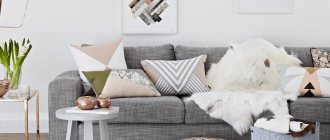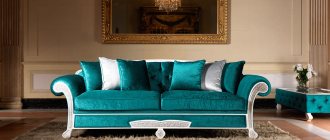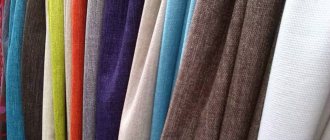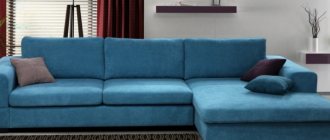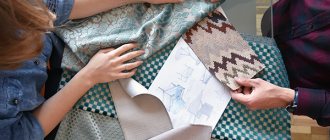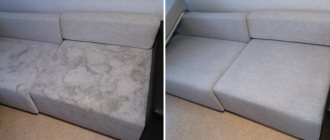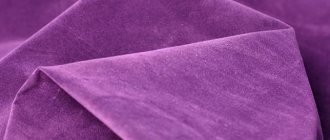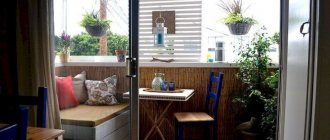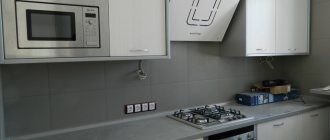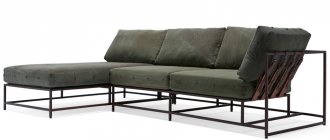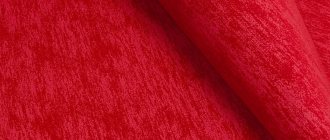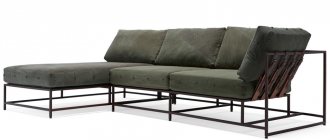Natural types of sofa upholstery
Natural textiles are leaders in the clothing segment due to their unique properties: good air permeability, hypoallergenicity, wear resistance and comfort.
However, for furniture production, all these qualities lose relevance due to the fact that the coating is under heavy load, even taking into account the fact that clothing samples differ in technology.
For upholstery of furniture, natural or mixed fabrics are used with the advantage of the following raw materials:
- cotton and linen. The optimal choice for children's furniture;
- wool. Not the best option. The fabric does not slip, but it itches and is prone to dust accumulation;
- thick silk. Used for reupholstering antique furniture.
Linen and cotton upholstery are a good option for a children's room. Such materials allow air to pass through, do not cause allergies and do not contribute to overheating.
In other cases they are rarely used. More often they are sheathed with textiles of mixed composition. Synthetic and artificial fibers extend the life of upholstery: they suffer less from external influences and are easy to care for.
One of the most comfortable and durable materials is high-quality genuine leather. However, its cost limits the availability of such furniture. Sofas and armchairs, covered with good leather, are status items and emphasize the presentability of the interior.
Suede
A living room or office space will be decorated with upholstered furniture covered with natural suede. But not every consumer can afford such things.
Suede leaves marks if not handled carefully. This material is not suitable for a sofa that serves as a sleeping place and for those who have small children and pets in the house.
Velvet
The refined and pathetic surface of velvet has not lost its relevance for decades. Most consumers, when choosing upholstery, try to ignore this option, and in vain.
The modern textile industry offers many options, different in shades and textures, and in the composition of raw materials. Natural cotton velvet, used in furniture production, is an expensive material that requires delicate care. But in living room sets it looks elegant.
Velvet is not suitable for a sofa that is constantly used as a sleeping place, despite its high wear resistance. To increase the service life of the material, manufacturers impregnate the canvas with special agents that reduce the absorption of moisture and odors and maintain color saturation.
Velvet made from mixed fibers is not inferior in beauty to cotton. Embossing options on the surface of the fabric allow you to choose a suitable interior.
Artificial velvet is an unpretentious fabric that tolerates washing well. Its cost is lower than the price of cotton and mixed samples. Natural velvet coating requires dry cleaning and careful use.
Jacquard
Interior jacquard is one of the most durable and beautiful materials. Its wear resistance is due to the special way the fibers are interwoven during the weaving process. The threads are located close to each other in the fabric, which ensures high density.
Jacquard is a heavy patterned fabric that is beautiful and expensive. The range offered by modern industry is amazing. But the main advantage of jacquard is the durability of the upholstery.
Jacquard fabrics can have a natural composition and include synthetic fibers. The fabric feels dense and slightly slippery to the touch. Considered a classic in residential design.
There are also disadvantages to jacquard upholstery. In addition to the high cost, it is necessary to note the tendency to form snags (due to the way the threads are intertwined) and delicate care. For samples made from natural materials, dry cleaning is required.
Pet owners are not advised to choose jacquard. Cats often leave claw marks on it in the form of elongated threads, which does not have the best effect on the appearance of the furniture.
Silk for sofas
There are practically no competitors for silk in the interior. Noble, refined fabric with a characteristic shine attracts the eye, makes you want to touch and feel the delicacy of the coating.
Despite innovative production methods, silk is not suitable for use as upholstery on furniture intended for daily use. Not everyone can afford such pleasure, but rather only those who put status above practicality.
Silk has always been considered an elite material for upholstery. Today it is used for the restoration of antique armchairs, chairs, and sofas.
If you still want to have upholstered furniture with silk coating in your interior, you should choose mixed, more practical materials with high density. An alternative option is to sew silk covers. They are easier to care for than permanent upholstery.
Tapestry fabric
It has been customary to cover furniture with tapestry fabrics since ancient times. Hand-woven canvases had fabulous prices, and the drawings on them told whole stories.
The relevance of tapestries has not been lost in modern design. The fabric is a type of jacquard woven from thick cotton threads. Some samples contain a small percentage of man-made fibers.
Thanks to the high density and thickness of the material, the upholstery lasts a long time without losing its original attractiveness. The variety of ornaments allows you to decorate the interior in various ways that meet modern trends.
When choosing tapestry fabrics, it is worth considering that too large sofas (for example, double ones) will look tacky. Therefore, tapestry is more suitable for compact pieces of furniture wardrobe.
The high cost is justified by the long service life. Tapestry canvases have a disadvantage - they are not resistant to intense exposure to sunlight, losing their richness of color. This property must be taken into account when planning the placement of furniture relative to windows.
Natural materials
Genuine Leather
Let's consider the most popular upholstery materials made from environmentally friendly raw materials. These fabrics are the safest for health; they will not harm either allergy sufferers or people suffering from bronchopulmonary diseases. Natural textiles breathe, absorb moisture from the air, and reduce static electricity.
Cotton
Cotton cover is soft and tactilely pleasant
Cotton A popular textile made from plant fibers of the cotton plant. This matter is one of the most common in the world, known since ancient times. It is used in almost all industries.
The advantages of cotton are its hygroscopicity and breathability. The matter is harmless and safe. It lends itself well to dyeing, so there are dozens of colors and prints.
Many people like the low price. The approximate service life with average wear will be no more than 5 years. Buy a sofa with cotton upholstery only if it is coated with a special anti-wear compound.
In addition to its short service life, an important disadvantage of cotton is flammability. It ignites very quickly and smokes heavily. Good upholstery fabric must be treated with fire-resistant impregnation.
Jacquard
Jacquard fabric has a relief texture
Jacquard Jacquard fabric is created by complex weaving, which simultaneously involves more than 24 intertwining threads. This allows you to create exquisite and ornate designs, unusual patterns, and intricate ornaments. The texture of such matter is very dense and embossed.
It is incorrect to call the fabric jacquard, as it is more of a weaving method. Therefore, both natural and artificial threads can participate in it. For furniture textiles, cotton, linen, wool or silk fibers are often used, combining them with synthetics.
Polyester makes the material strong, strong and durable. It does not fade in the sun and is highly breathable. Jacquard is treated with dust-repellent compounds, which makes it easier to clean.
Among the disadvantages, we note the high price, difficulty in care (the fabric does not like wet washing), and it is also slippery and cool to the touch.
Tapestry
The tapestry looks expensive and solid
Tapestry A textile fabric created by weaving many colored threads and simultaneously folding them into a pattern. The material turns out to be heavy, dense, two or three layers. The art of creating tapestries is the oldest applied craft, known since the times of the Egyptian pharaohs.
This upholstery has a very long service life and looks rich and expensive. Like jacquard, it contains a small percentage of synthetic fibers to improve physical properties. The disadvantage is the tendency to abrasion and fading in direct sunlight.
Silk
Fragile silk helps create a sophisticated atmosphere
Silk Smooth natural silk is used to decorate antique furniture or sofas in the artsy baroque style. The canvas is famous for its hypoallergenic and antistatic qualities. And it also looks chic, expensive, elegant.
Unfortunately, silk is very fragile and is not suitable for furniture that is used every day. The material is cool to the touch, this nuance is also considered a disadvantage.
Leather
Ideal for a study or office
leather is the most expensive and noble way to decorate your sofa. Such furniture is placed in living rooms, offices, and official rooms. Leather gives it a spectacular appearance, creates an atmosphere of prosperity, and makes a solid impression.
It can be matte, rough, glossy. There are many colors, options with a combination of shades. Gold or silver embossing, logos, and fabric stitching look good on the leather.
PROS:
- Durability (with proper care)
- Easy to clean (just wipe with a soapy cloth)
- Luxurious view
- Waterproof (within reasonable limits)
MINUSES:
- Price
- Flammability
- The surface of the material sticks to bare skin
- The coating is easy to scratch
- Will crack over time
Synthetic types of upholstery
Materials made from artificial fibers are not inferior to natural ones in terms of attractiveness. Their color range is much wider, and their prices are more affordable. The disadvantages include the ability to accumulate static electricity and attract dust. They are easier to care for.
Alcantara or faux suede
A worthy alternative to natural suede is artificial suede. It has a number of advantages:
- higher strength;
- inability to stretch during operation;
- easier to maintain, easy to clean;
- wide choice of colors;
- durability;
- affordable price.
There is also a similarity with natural suede: a velvety surface that is pleasant to the touch.
A new product on the market is a non-woven material that imitates suede. The production technology is simpler, and the price is accordingly affordable. However, in terms of main indicators, non-woven material is significantly inferior to textile material. It is less wear-resistant and short-lived.
Alcantara is an analogue of natural suede, named after the Italian brand that first mastered the manufacturing technology. The cost of this type is high, but the material guarantee is 10 years. It is easy to care for and resistant to external influences.
There are several replicas produced by enterprises in Turkey and China. The names and prices differ, but the service life of the fake is low. Therefore, when choosing, you should inquire about the country of origin of the material.
There are several varieties in the Alcantara production line: with and without backing, fire-resistant, two-color and monotone, with perforations and with ornaments. The consumer is offered more than 100 types of analogues of natural suede intended for upholstered furniture and car seats.
Teflon flock Curtisan
In the line of non-woven materials for upholstery of upholstered furniture and car seats, flock is a popular material - a soft and pleasant-to-touch material. Courtesan fabrics have a distinctive feature: they have high water-repellent properties and resistance to external damage, and the ability to “breathe”.
This material does not burn and is capable of demonstrating anti-vandal qualities. Pets will not be able to tear the coating with sharp claws.
Thanks to these properties, Courtesan flock is used for the production of upholstered furniture for catering establishments and offices.
Chenille fabric
Translated into Russian, “chenille” means “caterpillar”. The fabric received this name due to its structure. During the production process, fluffy fibers are twisted and woven into the fabric. According to the composition of the raw materials, it is divided into cotton, mixed and artificial chenille made from natural fibers, ideal for children's furniture.
Thanks to special technology, the fabric does not stretch, does not absorb odors, and does not wrinkle. Mixed fabrics are not used to cover corner sofas intended to complete kitchen sets. It is recommended to clean this material only with a dry method.
Artificial fur
One of the popular materials is faux fur. The range is very wide: various colors and imitation of noble fur.
When choosing it as a coating, you need to take into account that it is not suitable for intensive use. It is not recommended to cover folding sofas with fleecy fabrics, including faux fur. It is beautiful, but prone to abrasion, and is also difficult to care for.
Technological microfiber
Microfiber (euroflock, microfiber) is one of the most popular interior fabrics. It has several advantages: a wide selection of colors and textures, resistance to pilling; washes easily and does not fade.
Technological microfiber is safe for health, wear-resistant and practical. Despite its high density, the material has the ability to “breathe”. This is one of the most durable coatings used in the furniture industry. In addition to microfiber upholstery, sofa cushions are made.
Nylon fiber is used in the production of the material. Therefore, the canvas does not tolerate hot processing. In furniture items, woven fabrics are mainly used, less often non-woven ones. Microfiber does not accumulate dust and does not cause allergies. Special Teflon impregnations provide it with protection from water, dirt and dust.
Consumer reviews confirm that this material can last a long time without losing its attractiveness.
Anti-vandal fabric Verona
Furniture velor Verona was developed in the USA. Interior fabric is produced in Turkey. Velor fabrics are used as wall coverings. These solutions are dictated by modern design trends and cope well with the anti-claw function.
The soft fleecy surface, variety of colors and absolute resistance to external influences have made Verona popular in Europe and Russia. The properties are due to a unique technology: innovative weaving of fibers and double coating of pile are used in weaving.
The material drapes well, which is why it is widely used in interior design.
Microfiber Panda
Panda represents velor of the highest category made in Turkey with an anti-claw effect. This type of anti-vandal material has a wide color palette: from soft pastel tones to rich colors.
Like any type of artificial velor, it requires special care. When the fabric is exposed to temperatures above 60 degrees, the adhesive base is destroyed, which leads to abrasion and damage to the coating.
What qualities should upholstery meet?
Combining contrasting colors and different prints looks impressive
Some fabrics are easier to clean or wash, others are more durable, others look more luxurious or noble. Price also matters, because modern upholstered furniture is not cheap .
Most importantly, remember that the best fabric for a sofa is one that is safe for health, especially if the furniture is intended for a children's room.
Catalog of textiles for upholstered furniture
Furniture textiles are produced using special technology. Fabrics are different: with an unequal ratio of natural and artificial threads, with increased or standard strength characteristics, woven and non-woven, with or without synthetic fibers. All indicators are displayed in the technical document of the material and are indicated in a compressed form on the label.
Let's consider the parameters by which the material is evaluated:
- Resistance to wear of pile, rubbing of threads. This parameter determines whether the seats on the upholstery will become thinner, and whether they will then contrast with the back or armrests
- Color fastness . Good fabric does not fade over time and does not fade under the influence of UV rays
- Stability . The material should compress freely and immediately expand. Slight elasticity is welcomed for increased wear resistance
- Peelability . An unclear word means resistance to pile rolling and pellet formation.
- Availability of special impregnation. Most often, the fabric is treated with water-repellent compounds, as well as means to increase its strength.
- Fire resistance. There are impregnations that make raw materials slightly flammable. This is an important indicator from a fire safety point of view.
- Environmental friendliness . The highest rates are for natural materials. This upholstery is hypoallergenic
- Air permeability . Fabric that interferes with air circulation quickly becomes unusable. Over time it cracks and tears
Upholstery for sofas made of leather and leatherette
Furniture upholstered in leather looks stylish and presentable. The cost of natural material is very high, and various types of leatherette are an alternative option.
Eco-leather for upholstered furniture
Eco-leather is a material that differs from artificial leather in properties and manufacturing technology. Highly wear-resistant cotton fabrics are used as a base, on which a layer of polyurethane is applied. To increase strength, the surface is coated with Teflon at the final stage.
In appearance, the texture of the material resembles genuine leather, but unlike the latter, it is half the price. Abrasion resistance depends on the thickness of the polyurethane layer. The fabric has the ability to conduct vapors and air, which makes it safe.
Eco-leather can be used in a wide temperature range. Therefore, furniture with such upholstery can be used in open areas in hot weather and in cold weather. One drawback of the material is that if mechanical damage occurs, it is difficult to hide the defect, especially on samples of light shades.
Arpatek leatherette
Arptek is another high-quality imitation of genuine leather. The composition includes polyurethane, polyester, viscose and cotton. Synthetic fabric demonstrates a high degree of abrasion resistance. According to the Martindale test, the sample passed 200 thousand cycles.
Elastic fabric, as close as possible in external characteristics to natural leather, is easy to clean and does not lose its richness of color. But he is afraid of scratches that are not easy to disguise. Therefore, this type of upholstery is not suitable for pet owners.
Genuine furniture leather
Genuine leather is rightfully considered the most prestigious material for furniture upholstery. It is not afraid of intense loads, and mechanical damage appears on the coating in extremely rare cases.
Environmental friendliness and comfort are undeniable. In addition, upholstered furniture looks very expensive and representative. If treated with care, the service life will be more than a dozen years. Sometimes there may be a slight unevenness of color on the surface due to the structure of the fabric (the thickness of the skins is not uniform), but this will not spoil the appearance.
The only obstacle to using genuine leather for upholstery is the high cost of the material.
Arpatek and faux suede
This type of upholstery fabric has long been used only as upholstery for chairs. Arpatek is essentially a type of artificial leather. Distinctive properties of upholstery material:
- resistance to exposure to ultraviolet rays;
- high wear resistance - means long-term resistance to abrasion and strength before breaking;
- relatively high cost.
Faux suede is often used as an upholstery fabric. The non-standard texture and pleasant tactile characteristics of the fabric make this material quite popular. In addition, faux suede upholstery turns the furniture into a luxury item.
Tapestry
This is one of the types of soft upholstery fabrics, it has an interesting weave of yarn that creates an organic and unusual pattern. This type of furniture fabric has a huge number of different colors and all kinds of textures.
The anti-vandal properties of this fabric make it easy to care for. It is easy to wash. At the same time, it has a long service life, pleasant and practical properties. Tapestry is a fairly plastic material that can be easily used in any interior items. This material has a natural and aesthetically attractive appearance.
In this case, the tapestry is seriously damaged under various kinds of physical stress. It has a relatively high cost. However, it cannot be cleaned with wet cleaning agents.
Velvet
Velvet is a unique fabric that is equipped with a rather fluffy pile, but not long, but rather short. The long pile on velvet allows the fabric to be called velor and is suitable for the specific shape of interior items.
Velvet comes in a variety of patterns or solid colors. It is able to transform any simple piece of furniture into a sophisticated and luxurious one, as well as perfectly harmonizing with various classic styles of interior solutions.
The most commonly used color is black or blue velvet. They have the ability to create atypical atmospheres in all rooms.
Textured and pile types of upholstery
In the range of interior fabrics, a significant part is represented by textured materials and fabrics with a pile surface: flock, chenille, velor and many others. etc. When choosing, it is important to pay attention to the composition of the raw materials. It is not recommended to heat treat fabrics containing nylon.
The textured surface is achieved by special weaving of threads (like jacquard) or embossing on non-woven materials. Modern pile upholstery is often applied by spraying. The use of innovative technologies has made it possible to increase wear resistance and extend the service life of these materials.
Anti-vandal flock
The term anti-vandal flock refers to an anti-claw material that has increased strength and resistance to damage. The fabric is produced by gluing nylon fibers onto the front surface of the fabric.
The density of the pile ensures the softness of the material and its strength. The cat's claw cannot damage the surface by sliding off the nylon bristles. Teflon impregnation, used in the production of anti-claw flock, repels water and protects the fabric from dust and dirt.
This type of material is resistant to ultraviolet radiation, it does not fade or fade when cleaned. It is recommended to remove stains from flock without waiting for absorption. Do not clean with alcohol-containing products so as not to destroy the adhesive base. The upholstery should be vacuumed periodically.
It is necessary to take into account the ability of the material to absorb odors, so it is not advisable to cover sofas and chairs for the kitchen with flock.
Soft velor
Unlike flock, velor does not absorb odors, but is not so resistant to external influences. It tolerates cleaning well with a steam generator, does not fade, and does not lose its visual appeal.
The softness and beauty of the velor pile attracts with its sophistication. In terms of care and durability, velor is considered the best material in the mid-price upholstery segment.
The texture is smooth, shaped, embossed. A variety of shades allows you to choose the fabric to suit any interior.
Velor Galaxy
The difference between Galaxy velor and the line of pile fabrics is in the special processing of the fibers at the production stage. Antistretching effect makes the material incapable of stretching during operation.
The “easy cleaning” technology and water-repellent ability have made Galaxy widely used in the production of furniture for cafes, restaurants and other public places.
"Indestructible" matting
Matting is often used for making and upholstering furniture, despite the fact that the material is inferior in softness to other types. This is a type of chenille made from natural fibers (cotton, linen, matting) with the addition of synthetics.
Due to the special weaving, a unique pattern is formed on the surface. The dense material is durable and provides protection against sagging of the packing. It is used for upholstery of kitchen corner sofas, double sofas, children's sofas and in Eurobook models.
The matting does not cause allergic reactions, has the ability to “breathe”, and is easy to care for. In terms of wear resistance it is inferior to other interior synthetic materials, but in terms of safety it surpasses them.
Water-repellent microsuede
Microvelor differs from velor in the structure of the fabric. The fibers of the fabric do not exceed 1 mm, and the weaving is based on cells in the form of a honeycomb, which makes the fabric strong and durable.
Externally, both materials are similar. The water-repellent effect is created by Teflon impregnations, which in addition provide protection against contamination. Nylon or nylon fibers prevent animals from damaging the upholstery with sharp claws.
What to focus on when choosing so as not to make a mistake?
In order for the upholstery to last for a long time, you should pay attention to such important parameters as:
- External characteristics. The fabric should aesthetically fit into the interior of the room, but not merge with it and not be monotonous. Otherwise, over time it will lose its properties and will look sloppy. Therefore, experts recommend buying sofas with a three-dimensional pattern, which will disguise the lint that escapes.
- Wear resistance. To find out this parameter, you need to look at the product passport. The best option to purchase are models with a parameter of 20,000 abrasion cycles.
- Density. In this case, the minimum value should be 200 g/m. This is also indicated in the upholstery passport.
- Stability. The fabric should retain its shape after washing at home. Otherwise, you will have to send the product to the dry cleaner, which will significantly affect the buyer’s wallet.
- Formation of pellets (pillingability). Good upholstery, made from quality materials, can easily withstand over 500 friction cycles, which makes it non-pilling.
- To preserve the properties of the fabric for a long time, it must be pre-impregnated with Teflon, which will protect the product well from water, dirt, dust and increase its service life.
- Color fastness. The material must be resistant to sunlight and friction.
- Comfort. The fabric should not be too hard or scratchy.
When choosing upholstery, you must remember that it should be easily removable if it needs to be replaced or cleaned.
Inexpensive upholstery for sofas
The desire to purchase inexpensive, durable fabric is justified. Based on cost, categories for popular interior paintings are distinguished:
| Category | Name of fabrics |
| A budget option | Matting, microfiber, flock, microcorduroy, cotton chenille, cotton scotchgard |
| average price | Chenille bouclé, velor, faux leather |
| Premium class | Jacquard, tapestry, suede, genuine leather, silk |
Cotton Scotchgard
On the one hand, cotton tape is affordable and considered “rustic” by many. On the other hand, this material is produced by jacquard weaving of threads, which makes it beautiful and durable.
Furniture with such upholstery looks impressive, is practical, and meets safety requirements. But it has disadvantages: it can accumulate odors and is not resistant to cat claws.
Pleasant Boucle
Bouclé is a fabric texture obtained by weaving threads of different characteristics. The fabric is soft, slightly loose with a knotty surface. In the segment of inexpensive upholstery materials, furniture matting with a bouclé effect is popular.
It has good air conductivity and is suitable for any design. The fabric is hypoallergenic, which allows it to be used in children's furniture. It has a minus - low wear resistance and lack of anti-vandal effect (anti-claw).
Anti-claw upholstery fabric
Few people know that the term “anti-claw” is used as a marketing ploy. Sometimes a manufacturer labels interior materials to attract consumer demand. It is worth understanding that the animal loses interest in the upholstery if it cannot catch the thread with its claw. But the character of pets cannot be predicted. Anti-vandal materials for each of them will become an obstacle to “experiments”.
Characteristics of the canvas:
- the weave should be fine and as dense as possible;
- the pile is low, mainly made of synthetic fibers;
- the fabric does not crumble during friction;
- It is preferable to choose smooth fabrics;
- high wear resistance according to the Martindale test.
Summarizing the requirements for anti-vandal fabrics, the most practical samples are:
- artificial suede anti-claw;
- flock;
- velours;
- microfiber;
- corduroy mixed or synthetic.
What is the fabric category
There is a certain classification into categories. Thanks to this, you can find out not only the performance characteristics, but also understand how high-quality the fabric used for upholstery is. The higher the category, the denser and more expensive the materials.
| Category no. | Fabric type |
| 0 | Lightweight materials - cotton, thermal jacquard, scotchgard, light series of chenille fabrics. Suitable for furniture that is rarely used. Durability up to 5 thousand cycles according to the Martindale test. |
| 1 | Somewhat denser than the previous category. Not suitable for upholstering chairs, children's furniture and kitchen furniture. Durability up to 7 thousand cycles according to the Martindale test. |
| 2 | Fabrics of the first category, but with increased density and wear resistance (jacquard, flock, corduroy). Withstand 10-12 thousand abrasion cycles. |
| 3 | Fabrics with non-standard weaving, denser and thicker. Durability is about 15 thousand cycles according to the Martindale test. |
| 4 | Very dense fabrics - tapestry, bouclé chenille, suede with a pattern. Wear resistance - 18 thousand cycles according to the Martindale test. |
| 5 | Fabrics with lining or admixture of natural fibers. Withstands 20-22 thousand abrasion cycles. |
| 6 | Leatherette with a wear resistance of about 30-50 thousand cycles according to the Martindale test (Arpatek, eco-leather, nano-leather). |
| 7 | Genuine leather of varying degrees of tanning. Premium materials with complex woven patterns, high levels of wear resistance. Durability of at least 50 thousand cycles according to the Martindale test. |
The higher the number, the higher quality the fabric for the sofa. Naturally, it makes it more expensive. But if you choose the right product and properly care for it, even category 0 can last a long time.
Select by purpose
After familiarizing yourself with the qualities of each upholstery fabric, you decide on your choice. The first thing you should pay attention to is the purpose of the piece of furniture and the expected service life and intensity.
For children's models
For sofas and armchairs that are planned to become furnishings for a children's room, it is worth giving priority to safety. It is advisable to choose materials made from cotton and linen that are not too wear-resistant for furniture that can be changed as the child grows.
For practical consumers who are not ready to change furnishings after 2-3 years, it is recommended to give preference to cotton upholstery with the addition of synthetic and artificial fibers to increase service life.
To the living room
For living rooms, you should choose expensive and presentable fabrics that are practical and durable.
The intensity of use of furniture pieces is important for choosing in terms of wear resistance.
For the bedroom
Bedrooms will require upholstery with a high abrasion resistance rating. This aspect is important for folding sofas and “Eurobooks”.
If you are prone to allergic reactions, preference is given to mixed materials containing at least 50% natural fibers.
To the kitchen
Upholstery material for kitchen sofas must be protected from moisture and dirt. If there are animals in the house, then the anti-claw effect will guarantee long-term use of the furniture.
It is not recommended to use fabrics with a loose texture (chenille, faux fur, some types of flock and velvet). They get dirty faster and are more difficult to clean. In addition, some materials can absorb odors.
Fabric for upholstery of upholstered furniture is chosen according to its intended purpose.
Advantages of fabric upholstery
The material for the sofa affects the comfort and ease of use of the furniture. Thanks to the variety of colors and patterns, you can choose a product that will go well with any room. The chosen canvas carries not only aesthetic significance. It provides protection for the inside of the product. The coating protects against dust, dirt, and moisture. It becomes easier to care for, although not all types of upholstery fabrics require the use of wet cleaning.
Most types of materials are affordable, and sofas with them can be purchased even on a limited budget. The choice should be made based on personal preferences, including depending on the room in which the furniture is intended. For example, a product with leatherette upholstery is an excellent solution for the kitchen. There is a huge selection on the market today, so finding something interesting will not be difficult. To find out which sofa upholstery is better, it is recommended to first familiarize yourself with the properties of the fabric.
Since Soviet times, matting has been used for upholstery of upholstered furniture. It is a durable fabric woven by weaving thick fibers. Velor is popular today. This raises the question of what is better for a sofa – velor or matting. Matting is characterized by strength and rigidity, and velor is soft. From the point of view of long-term use, it is recommended to choose hard upholstery, for your own comfort - soft.
Matting: main features
Matting is a textured fabric with a unique weave of threads, somewhat reminiscent of burlap. It is also a durable fabric that is high quality and extremely durable. As a rule, fabric with straight shapes is used for upholstery of sofas; it does not withstand the physical and mechanical impact of pets; in particular, cats or dogs can easily ruin the sofa. Because of the convex structure of the weave, the threads are very easy to pick up and pull out. Today, matting sofas look good in a variety of styles: in an ecological style, as well as in minimalism and other modern trends.
Velours
This type of upholstery velvet is durable and wear-resistant. The pleasant soft structure is well suited for covering any furniture; it has a soft velvety surface. It can be made from both natural fabrics and synthetic fiber.
More common are velor fabrics with a combination of natural and synthetic fibers. There are endless variations and designs on the market.
Kinds:
- Smooth.
- Embossed.
- Split.
- Looped.
Upholstery velvet, produced using the two-sheet method, does not have loops in its structure . Suitable for upholstering furniture in homes with animals. The cat will not be able to catch its claw on the canvas. This property of the fabric was given the definition of “anti-claw” .
When producing upholstery using the rod method, tiny loops appear on the canvas, which form its basis.
Velor has become the most common upholstery fabric due to its variety of colors and designs.
Reliability indicators of matting and velor
As a rule, the reliability of upholstery is determined by a special test, it determines the abrasion of the fabric, the unit of measurement is thousands of cycles. The principle is as follows: the upholstery is rubbed in a circular motion many times, thus calculating how many cycles a given fabric can withstand.
It is recommended to pay special attention to the density of the fabric; the higher it is, the higher the density of the material itself.
Today, furniture manufacturers offer a wide range of upholstery fabrics for upholstered furniture, which have varying degrees of density. Velor and matting are characterized by approximately the same density, so both materials will last a long time and will delight you with their appearance and positive qualities.
